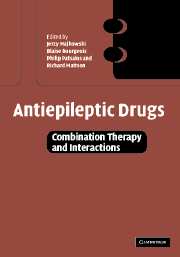Book contents
- Frontmatter
- Contents
- List of contributors
- Foreword
- Foreword
- Acknowledgements
- Part I Introduction
- Part II Pharmacokinetic interactions
- Part III Pharmacodynamic interactions
- 9 Pharmacodynamic principles and mechanisms of drug interactions
- 10 Methods for assessing pharmacodynamic interactions
- 11 Experimental studies of pharmacodynamic interactions
- 12 Clinical studies of pharmacodynamic interactions
- 13 Clinical studies of pharmacodynamic interactions between antiepileptic drugs and other drugs
- Part IV Drug interactions in specific patient populations and special conditions
- Part V Conclusions and future perspectives
- Index
12 - Clinical studies of pharmacodynamic interactions
from Part III - Pharmacodynamic interactions
Published online by Cambridge University Press: 07 September 2009
- Frontmatter
- Contents
- List of contributors
- Foreword
- Foreword
- Acknowledgements
- Part I Introduction
- Part II Pharmacokinetic interactions
- Part III Pharmacodynamic interactions
- 9 Pharmacodynamic principles and mechanisms of drug interactions
- 10 Methods for assessing pharmacodynamic interactions
- 11 Experimental studies of pharmacodynamic interactions
- 12 Clinical studies of pharmacodynamic interactions
- 13 Clinical studies of pharmacodynamic interactions between antiepileptic drugs and other drugs
- Part IV Drug interactions in specific patient populations and special conditions
- Part V Conclusions and future perspectives
- Index
Summary
Introduction
This chapter addresses the clinical impact of pharmacodynamic (PD) interactions of antiepileptic drugs (AEDs) and the strategies that have been used to discover these interactions. Particular attention is paid to the limitations of available studies and the chapter concludes with a summary of expert opinion about optimal study design for identifying PD interactions. For the purposes of this chapter, the definition of a PD interaction is the interaction of two drugs causing a greater or less than expected effect or side-effect in the absence of a pharmacokinetic interaction.
Polypharmacy has undergone a renaissance since the early 1980s (Goldsmith and de Bittencourt, 1995). The old arguments against combination therapy were predicated upon the observation that refractory patients placed in polytherapy were experiencing increased adverse events without better efficacy (Schmidt, 1982). Since then, the advent of monitoring AED levels and a deeper understanding of the mechanisms of AED action have led to more effective use of rational polypharmacy. A combination of drugs can now be used which suppress excitation, enhance inhibition, and work by other novel mechanisms, thus providing a previously lacking theoretical construct for the assertion that the efficacy of combinations of drugs can be additive or supra-additive. In addition, monitoring of AED levels can limit pharmacokinetic variation that often used to cause adverse events when drugs were combined. The clinician's goal is to identify combinations that improve effectiveness, a goal that could be achieved more often if natural synergies could be identified.
Keywords
- Type
- Chapter
- Information
- Antiepileptic DrugsCombination Therapy and Interactions, pp. 228 - 240Publisher: Cambridge University PressPrint publication year: 2005



